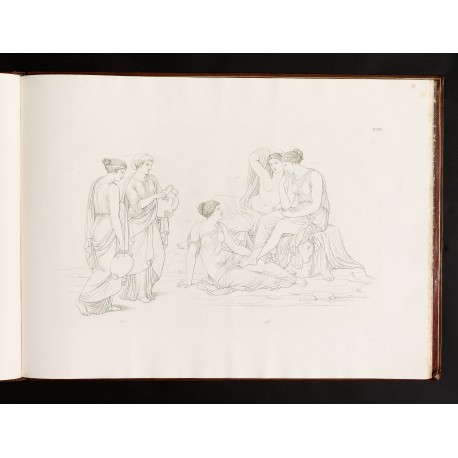Peintures de Polygnote à Delphes dessinées et gravées d’après la description de Pausanias par F. & I. Riepenhausen
- Subjects
- Archaeology, Greek & Roman
- Book illustration - Artists, German - Riepenhausen (Franz), 1786-1831
- Book illustration - Artists, German - Riepenhausen (Johannes), 1788-1860
- Mural painting and decoration, Greco-Roman
- Authors/Creators
- Riepenhausen, Franz, 1786-1831
- Riepenhausen, Johannes, 1788-1860
- Artists/Illustrators
- Riepenhausen, Franz, 1786-1831
- Riepenhausen, Johannes, 1788-1860
- Printers/Publishers
- De Romanis, Filippo & Nicola (Stamperia De Romanis), active 1812?-1844?
- Other names
- Pausanias Periegetes, c. 115-c. 180
- Selenka, Philipp, 1803-1850
Riepenhausen, Franz and Johannes
Göttingen 1786 – 1831 Rome; Göttingen 1788 – 1860 Rome
Peintures de Polygnote à Delphes dessinées et gravées d’après la description de Pausanias par F. & I. Riepenhausen.
Rome, [Filippo & Nicola de Romanis], 1826–1827; 1829
Two works in one volume, oblong folio (377 × 580 mm).
i: (2) ff. letterpress, unsigned and unpaginated (set in two columns, headings Avant Propos and Description du Tableau de Polygnote représentant la Descente d’Ulysse aux Enfers; colophon, Imprime a Rome par Phil. et Nicol. De Romanis avec Approbation en 1827); plus twenty numbered plates (including title).
ii: (1) f. letterpress, unsigned and unpaginated (drop-title, Description du Tableau de Polygnote représentant la prise de la ville de Troie et le départ des Grecs); plus eighteen numbered plates (the first a sub-title, Peintures de Polygnote à Delphes dessinées et gravées d’après la description de Pausanias par F. & I. Riepenhausen, dated 1829).
Foxed. Corners of the binding slightly abraded.
bound in contemporary russia leather, decorated in gilt; engraved ticket printed on white paper Gebunden bei Ph. Selenka in Wiesbaden.
A set of engravings recreating an image of legendary beauty, the lost Polygnotan paintings in the Cnidian Treasury at Delphi. The reconstruction is based on the second-century description of the paintings given by Pausanias (Periegesis, x, 25–31) and the prints are executed in the Flaxmanesque outline style then deemed appropriate to a serious archaeological endeavour. The twenty plates of the first part imagine Odysseus’s Descent to the Underworld (left wall); the eighteen plates of the second part depict the Sack of Troy (right wall).1
The project had been conceived in 1803 by the brothers Riepenhausen, then living in Göttingen, where their father (himself an engraver) worked on the Göttingen editions of Flaxman. In that year they sent to Goethe at Weimar twelve of their drawings reconstructing the Fall of Troy. Goethe warmly commended their project, and in 1805 a series of fifteen engravings after the Riepenhausens’s drawings appeared.2 The second part illustrating Odysseus’s visit to the ‘Necyia’ was conceived at Rome in 1826–1827.
The present edition joins the two parts, with the first part substantially reworked: ‘Die Darstellung ist hier grösser als in der ersten Ausgabe und weit mehr in griechischem Geiste und nach den Eigentümlichkeiten der griechischen Malerkunst’.3

Our copy contains the engraved ticket of the bookbinder Philipp Selenka (1803–1850) of Wiesbaden, brother of Johann Jacob Selenka (1801–1871), Hofbuchbinder in Braunschweig.4
references Andreas Andresen, Die deutschen Maler-Radirer des 19. Jahrhunderts (Leipzig 1869), iii, pp.120–121 no. 16; Leonora Navari, Greece and the Levant: the catalogue of the Henry Myron Blackmer collection of books and manuscripts (London 1989), p.300 no. 1421 (first part only)
1. For this and other efforts to render in visual form the lost art works, see Following Pausanias: The quest for Greek Antiquity, catalogue of an exhibition held at the Gennadius Library, Athens, edited by Maria Georgopolou (New Castle, de 2007), pp.185–189 (with four reproductions from a coloured copy in a private collection).
2. F. and J. Riepenhausen, Gemaelde des Polygnotos in der Lesche (Göttingen 1805). Printmaking in the Age of Goethe, catalogue of an exhibition, British Museum (London 1994), p.173; Wiedergeburt griechischer Götter und Helden: Homer in der Kunst der Goethezeit, catalogue of an exhibition in the Winckelmann-Museum, 6 November 1999–9 January 2000 (Mainz 1999), pp.95–96 no. iii, 16 (copy in Freie Universität Berlin); Zwischen Antike Klassizismus und Romantik Die Kunstlerfamilie Riepenhausen, catalogue of an exhibition Winckelmann-Museum (Mainz 2001), pp.52– 53 nos. ii, 5–6. The copy in UB Heidelberg is digitised: http://digi.ub.uni-heidelberg.de/diglit/riepenhausen1805a/.
3. Neue Jahrbücher für Philologie und Paedagogik. Ester Jahrgang (1831), ii/1, p.119 (obituary notice of Franz Riepenhausen). On the differences between the plates in the two versions of part i, see Goethe und die Kunst, catalogue of the exhibition held at the Schirn Kunsthalle, Frankfurt, edited by Sabine Schulze (Stuttgart 1994), pp.340–342 no. 216; and Zwischen Antike Klassizismus und Romantik, op. cit., pp.54–55 no. ii, 7 (a hand-coloured copy in the Goethe-Museum featured in both exhibitions).
4. Two bindings by Philipp Selenka in the Fürstlich Waldecksche Hofbibliothek, Arolsen, are described by Rudolf-Alexander Schütte and Konrad Wiedemann, Einbandkunst vom frühmittelalter bis Jugendstil aus den Bibliotheken in Kassel und Arolsen, Universitätsbibliothek Kassel (Kassel 2002), p.54 no. 68 and Abb. 51. He was a specialist ‘Portefeuillearbeiter’; see Hektor Rössler, Ausführlicher Bericht über die von dem Gewerbverein für das Großherzogthum Hessen im Jahre 1842 veranstaltete Allgemeine deutsche Industrie-Ausstellung zu Mainz (Darmstadt 1843), p.240.





